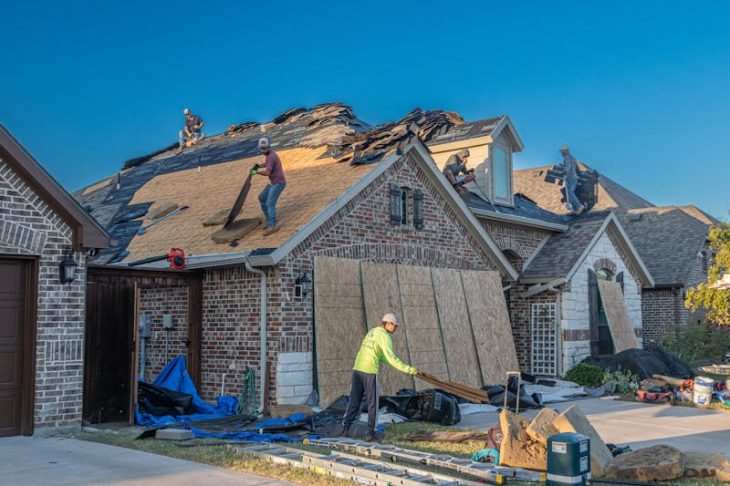
Water Leaking From Ceiling: Causes, Fixes & Prevention Tips
Few things are more stressful for homeowners than noticing water leaking from the ceiling. It’s not only unsightly but also a warning sign of potential structural damage, mold growth, and expensive repairs if left untreated. Whether the leak is a small drip or a steady flow, it’s important to act quickly.
This guide explains the common causes of ceiling leaks, what steps to take immediately, repair options, and long-term prevention tips. Written for homeowners, this article breaks down everything in simple terms so you can understand and tackle the problem confidently.
Common Signs of a Ceiling Leak

Water damage isn’t always obvious at first. Spotting early signs can help prevent bigger issues. Look out for:
- Water stains or discoloration – Brown or yellow marks often appear around the leak.
- Peeling paint or bubbling plaster – Moisture behind surfaces causes materials to swell.
- Dripping water – The most obvious sign of an active leak.
- Sagging ceiling – Indicates trapped water that adds weight and weakens the structure.
- Mold or musty odors – Moist conditions create a perfect environment for mold growth.
If you notice one or more of these symptoms, it’s time to investigate.
Causes of Water Leaking From the Ceiling
A ceiling leak can be stressful, but understanding the possible sources makes troubleshooting much easier. Water can travel from one area of the home to another, so the visible stain on your ceiling might not be the exact spot where the leak starts. Below are the most common causes to look for:
- Roof Damage
Your roof is the first line of defense against rain, snow, and wind. If it has weak spots, water can quickly make its way into your ceiling.
- Missing or damaged shingles – Strong winds or heavy storms can loosen shingles, leaving gaps where rainwater seeps through.
- Cracked or deteriorated flashing – The thin metal strips around chimneys, vents, or skylights are meant to keep water out, but when they crack or rust, leaks develop.
- Poor roof drainage – Clogged gutters or low-slope roofing can cause water to pool, eventually forcing its way inside.
A professional roof inspection is often needed to pinpoint the problem, especially if the damage isn’t obvious from the ground.
- Plumbing Issues
If the leak is located under a bathroom, kitchen, or laundry area, plumbing problems may be the cause.
- Leaky pipes in upper floors or the attic – Small drips from water supply lines or drain pipes can travel downward into ceilings.
- Faulty fittings or loose joints – Over time, connections in the plumbing system may weaken and allow leaks.
- Appliance or fixture overflows – Water from sinks, tubs, toilets, or washing machines can spill into floors and show up as stains below.
These leaks can be continuous or intermittent, depending on when water is used, making them tricky to trace without professional help.
- HVAC Problems
Your heating and cooling system can also be the source of hidden water leaks.
- Air conditioner condensation – When an AC unit or ductwork creates condensation, the water needs to drain properly. If it doesn’t, it can drip into the ceiling.
- Clogged drain lines – A blocked condensate line will cause water to back up, often leaking through the ceiling near where the unit is installed.
HVAC-related leaks are especially common in warm, humid climates where air conditioning runs frequently.
- Attic Condensation
Moisture inside the attic is another overlooked cause of ceiling water stains.
- Poor insulation – Without proper insulation, warm air from living spaces rises into the attic and meets cold surfaces, creating condensation.
- Lack of ventilation – A poorly ventilated attic traps moisture, leading to dampness, mold growth, and eventual leaks.
This type of leak often appears during winter months and may be mistaken for roof damage.
- Bathroom Leaks
Bathrooms are one of the most common sources of water damage because of their constant exposure to moisture.
- Faulty shower pans or cracked tiles – Water can seep through gaps in flooring and walls, trickling into the ceiling below.
- Worn caulking or grout – Even small gaps around tubs or showers allow water to escape over time.
- Leaky toilet seals or overflowing bathtubs – These can send large amounts of water directly into the ceiling beneath.
Since bathrooms have multiple fixtures close together, identifying the exact source often requires careful inspection.
What To Do Immediately When You Notice a Leak

When you spot water leaking from the ceiling, acting fast can prevent serious and costly damage to your home. Taking the right steps immediately will help you protect belongings and limit structural issues.
- Move Belongings Out of the Way
- Protect furniture & electronics – Relocate items like couches, beds, TVs, and computers away from the leak to prevent water damage.
- Cover immovable items – If moving furniture isn’t possible, cover them with plastic sheets or waterproof tarps for protection.
- Contain the Leak
- Use buckets or pans – Place containers under the drip to collect water and avoid pooling on the floor.
- Lay down towels – Spread absorbent towels or rags around the area to catch splashes and reduce slipping hazards.
- Relieve Ceiling Pressure
- Check for bulging spots – If water builds up in the ceiling, it may create bulges or sagging drywall.
- Puncture a small hole – Use a screwdriver or nail to carefully create a drainage hole, allowing water to escape in a controlled way instead of bursting unexpectedly.
- Turn Off the Water Supply (if plumbing-related)
- Shut off main valve – If the leak is from a burst pipe or faulty plumbing, turning off the main water supply prevents more water from entering.
- Drain excess water – After shutting off the supply, open taps to release pressure from the system.
- Cut Off Electricity in the Affected Area
- Switch off at the breaker – If the leak is near ceiling lights, fans, or outlets, immediately shut down power to avoid electrical hazards.
- Wait for inspection – Do not restore electricity until the area is fully dry and checked by a professional.
- Call a Professional
- Roofers, plumbers, or contractors – Depending on the source, a licensed expert can diagnose and repair the root issue.
- Document the damage – Take photos and notes for insurance purposes before cleanup or repairs begin.
Short-Term Fixes vs. Long-Term Solutions
Short-Term Fixes
- Patch roof holes with tarp until permanent repair is done.
- Tighten or tape leaky plumbing joints temporarily.
- Use waterproof caulking around showers, tubs, and sinks.
Long-Term Solutions
- Replace damaged roofing materials.
- Reroute or replace faulty plumbing pipes.
- Upgrade insulation and ventilation in the attic.
- Install water detection devices for early warning.
Short-term fixes can help you manage immediate damage, but only permanent repairs will stop the problem for good.
Repair Costs: What to Expect
Repair costs for water leaking from a ceiling vary depending on the cause:
- Roof repairs – $300 to $1,500 for patching, more for full replacement.
- Plumbing repairs – $150 to $800 depending on the location of the leak.
- Ceiling repairs – $500 to $2,000 for drywall replacement, repainting, and finishing.
- Mold remediation – $500 to $6,000 depending on severity.
Catching leaks early can save you thousands in repairs.
When To Call a Professional
While some small leaks can be managed with DIY methods, many require professional help. Call an expert if:
- You cannot identify the source of the leak.
- The leak is continuous or worsening.
- Your ceiling is sagging or at risk of collapse.
- You suspect mold growth.
- The problem involves electrical wiring.
Preventing Ceiling Leaks
Prevention is key to avoiding the stress and expense of ceiling water damage.
- Inspect your roof twice a year for missing shingles or cracks.
- Clean gutters regularly to prevent water buildup.
- Check plumbing connections for drips or corrosion.
- Maintain HVAC systems and keep drain lines clear.
- Seal bathroom fixtures with waterproof caulking.
- Improve attic insulation to reduce condensation.
Simple maintenance goes a long way in preventing future leaks.
DIY vs. Professional Repairs
Homeowners often wonder whether they should attempt ceiling leak repairs themselves.
DIY may work for:
- Temporary roof patching.
- Re-caulking tubs and sinks.
- Clearing clogged HVAC drain lines.
Hire a professional for:
- Major roof or plumbing repairs.
- Mold removal.
- Structural ceiling damage.
Choosing the right approach ensures safety and long-term results.
How Water Leaks Affect Your Home Over Time
Ignoring a ceiling leak can lead to serious consequences:
- Structural damage – Wood framing can rot and weaken.
- Electrical hazards – Water near wiring may cause shorts or fires.
- Mold growth – Can spread quickly and cause health problems.
- Decreased property value – Water damage lowers home resale appeal.
This is why quick action is always best.
Insurance and Ceiling Leaks
Many homeowners’ insurance policies cover sudden ceiling leaks caused by accidents, but not gradual damage from neglect.
- Covered: Burst pipes, storm damage, sudden roof leaks.
- Not covered: Ongoing roof wear, poor maintenance, mold from neglect.
It’s important to document damage with photos and contact your insurance company promptly.
Conclusion
Water leaking from the ceiling should never be ignored. Whether caused by roof damage, plumbing problems, or HVAC issues, leaks can quickly escalate into costly repairs and health hazards. By identifying the signs early, acting quickly, and choosing the right repair solutions, you can protect your home from serious damage.
Regular inspections, simple maintenance, and preventative steps are the best defense against future leaks. And when in doubt, call in a professional to handle major repairs.

